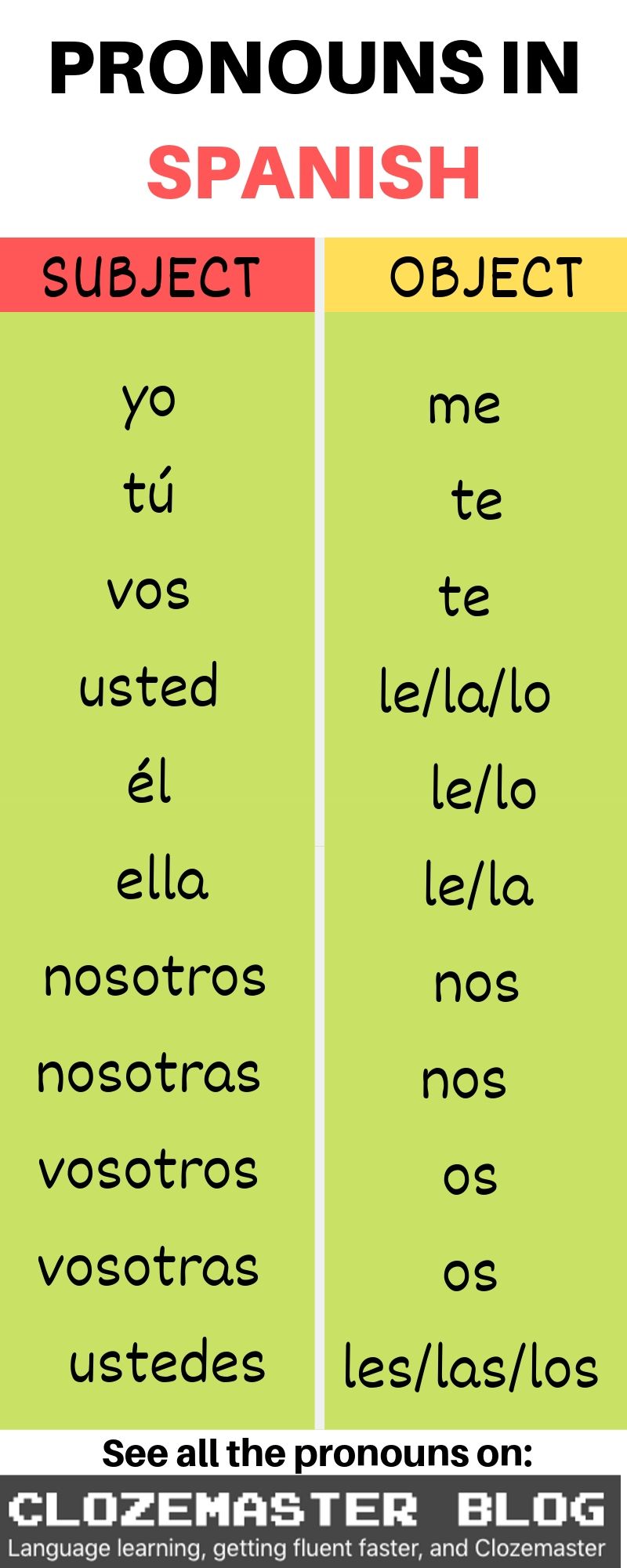Hi, my name is Suzie and I’ve been tasked with the impossible feat of describing all the Spanish pronouns to you. I won’t claim that it’s going to be easy – in fact, Spanish pronouns are one of the last things I fully understood about the language. But they are extremely necessary, and used daily in conversations, so it’s really important to learn them as much as you can!
What is a pronoun?
Don’t feel silly if you don’t know what a pronoun is; many people don’t. Many other people think of pronouns as just words like me, you, him, etc., but there is more to it than that. The best way to describe a pronoun is something that stands in the place of a noun in a sentence. A pronoun represents someone or something, without specifying exactly what it is.
This vague definition is exactly why pronouns are so hard to define and some linguists debate about what is and isn’t one. That obviously doesn’t help you Spanish learners trying to get your head around the Spanish pronouns, though! So, let’s start with the basics for today, and look at the main, undisputed Spanish pronouns and how to use them.
Subject and object personal pronouns in Spanish
Let’s look at the main subject and object pronouns in Spanish, and then some frequent questions students have about them.
| Subject | Object | ||
| I | yo | me | me |
| you | tú | you | te |
| you (formal) | usted | you | le/la/lo |
| he | él | him | le/lo |
| she | ella | her | le/la |
| we | nosotros/as | us | nos |
| you (plural) | vosotros/as | you | os |
| you (formal/plural) | ustedes | you | les/las/los |
| they | ellos | them | les/los |
| they (females) | ellas | them | les/las |
How to know when to use subject and object pronouns in Spanish?
So, what is the difference between subject and object pronouns? The easiest way to understand it is to think of the difference between “I” and “me” in English. For example, we say “I love dogs”, but “dogs love me”. If we used the wrong pronoun in either case, the sentence would sound weird, right? That’s because “I” always has to take the subject position (before the verb) and “me” always has to take the object position (after the verb).
Other distinctions are he vs. him, she vs. her, we vs. us, and they vs. them.
Spanish makes the exact same distinction as English between subjects and objects. Only Spanish takes it a bit further and distinguishes between subjects and objects of “you” as well. This can cause some confusion for English natives, but if you remember it’s the same as the difference between “I” and “me”, that should help you get your head around it!
Where to put the object pronoun in Spanish?
Another thing that can cause confusion with the Spanish object pronouns, is their place in the sentence. In English, object pronouns will almost always come after the verb, but it’s not the case in Spanish. Spanish object pronouns can appear before or after the verb, depending on the sentence structure.
If the main verb is conjugated, the object pronoun should come before verb. For example:
- (Yo) te amo. | I love you.
- (Yo) Lo veo.| I see him.
- (Tú) me haces feliz. | You make me happy.
- (Él) no os cree. | He doesn’t believe you (plural).
- (Ellos) nos discriminan. | They discriminate against us.
If the main verb is in its infinitive form, the position of the object pronoun is optional. You can either place it before the conjugated modal, or attach it on to the end of the infinitive verb to make one longer word. Crucially, you can never have something filling both positions at the same time. For example:
- Ella me quiere decir algo. OR Ella quiere decirme | She wants to tell me something.
- Nosotros lo vamos a ver esta noche. OR Nosotros vamos a verlo esta noche. | We are going to see him.
- Ellos me están despidiendo. OR Ellos están despidiéndome. | They are saying goodbye to me.

What is the difference between le/lo/la etc. in Spanish?
If you looked at the table above, you might be wondering why there are two ways to say “him”, and three different ways to say “them”? Not to mention all the different versions of “you”. I get it; it’s confusing. But there is a method to this madness.
In short, it comes down to the distinction between direct and indirect objects. If you’re not quite sure of the difference between these two, a simple way to remember it is the direct object is the recipient of the action of the verb, whereas the indirect object is the recipient of the direct object.
For example, if you “throw him”, “he” is the one who gets hurled away, but if you “throw him the ball”, “he” safely receives the ball. In the first sentence, the pronoun “him” is acting as a direct object, whereas in the second one, “him” is the indirect object.
In Spanish, the same word is not used for direct “him” and indirect “him”. This makes sentences a lot less ambiguous than they would be in English. So, for direct objects, use lo or la. For indirect objects, use le. For example:
- Le tiré una pelota. | I threw him a ball.
- Lo tiré. | I threw him.
The second distinction is between masculine and feminine. Both males and females will take le as the indirect object, but for direct objects, the distinction must be made. So la means “her” and lo means “him” only when they are direct objects.
This works exactly the same way for the formal “you”. Use lo for direct you when the person you are addressing is male. Use la for direct you when the person you are addressing is female. And use le for indirect object, regardless of the gender of the person you are addressing.
You can also apply all of the same rules for plurals, including ustedes, ellos, and ellas. The only difference with the plural is that you have to remember to add the ‘s’ to the end of each pronoun!
How to distinguish between “you” and “them”?
You might be thinking, if you use the same pronouns for second person formal and third person, how would you tell which you are talking about when situations can be ambiguous? Well, you can actually specify exactly who you are talking about by adding a + the prepositional pronoun (same as the subject pronoun) after the verb. This can also be used for emphasis. For example:
- Quiero verlo a él. | I want to see him.
- Voy a comprarle a ella esa camisa. | I want to buy her that shirt.
- No los hablo a ustedes. | I don’t talk to you (formal/plural).
Note that the prepositional pronouns can be omitted from the above sentences when the subject is understood from the conjugation or from the context. But if you do include them, they will always come before the object pronoun in the sentence. Also, remember the prepositional pronouns are there for emphasis only and do not mean that you can omit the object pronoun. The object pronoun is still obligatory in these kinds of sentences.
Curious about Spanish prepositional pronouns? Let’s look at those in a bit more detail!
Prepositional pronouns in Spanish
| me | mí |
| you | ti |
| you (formal) | usted |
| he | él |
| she | ella |
| we | nosotros/as |
| you (plural) | vosotros/as |
| you (formal/plural) | ustedes |
| they | ellos |
| they (females) | ellas |
As you can see, these are exactly the same as the subject pronouns with two exceptions – the first and second person pronouns.
Spanish prepositional pronouns can be used in the way described above, for emphasis or clarification, but they are also the pronouns that will appear after any preposition, such as de, para, en, a, etc. For example:
- Tengo algo especial para ti. | I have something special for you.
- Siento algo dentro de mí. | I feel something inside of me.
Reflexive pronouns in Spanish
Reflexive pronouns are pronouns that refer back to yourself. These are almost the same as object pronouns, with just a few exceptions. This is described in detail in our post about the Spanish reflexive.
Possessive pronouns in Spanish
| Determiner | Pronoun | ||
| my | mi | mine | mío/a |
| your | tu | yours | tuyo/a |
| your (formal) | su | yours (formal) | suyo/a |
| his | su | his | suyo/a |
| her | su | hers | suyo/a |
| its | su | N/A | |
| our | nuestro/a | ours | nuestro/a |
| your (plural) | vuestro/a | yours (plural) | vuestro/a |
| your (plural/formal) | su | yours (plural/formal) | suyo/a |
| their | su | theirs | suyo/a |
Look at the table above for a few moments. What’s the first thing you notice?
There is a lot of su and suyo, right? In fact, more than half of the table is taken up with this same word. How does that work? you might be asking. How on earth would you know whether someone is talking about their dog or your dog or his dog? Thankfully there are some very easy ways to distinguish between all these different meanings, which are very commonly used in Spanish.
Instead of saying su or suyo you can simply say de + the owner. So for example:
Instead of ese es su perro, you can say…
- Ese es el perro de usted. | That is your dog.
- Ese es el perro de él. | That is his dog.
- Ese es el perro de ella. | That is her dog.
- Ese es el perro de ustedes. | That is your (plural) dog.
- Ese es el perro de ellos. | That is their dog.
- Ese es el perro de ellas. | That is their (female) dog.
Likewise, ese perro es suyo, can become…
- Ese perro es de usted. | That dog is yours.
- Ese perro es de él. | That dog is his.
- Etc.
The difference between possessive determiners and possessive pronouns in Spanish
Technically, possessive determiners are not pronouns at all. But they are in this post because it is easy to mix them up, so it’s best you understand the difference. Luckily, there are more distinctions for these in English than there are for personal pronouns, so it is easier to understand the difference. But generally speaking, determiners are always followed by nouns, whereas pronouns replace nouns.
For example, la maleta can become mi maleta (my suitcase), and esa es una maleta can become esa es mía (that’s mine).
It’s all pretty straightforward and looks like it functions the same as in English up to this point. But Spanish possessive pronouns can also be used as adjectives, and that’s where it can throw some people off. This is common only in the first person, and so can be thought of as a translation for “of mine”. Some common examples of this:
- Una amiga mía | A friend of mine
- Díos mío | My god (colloquially: oh my god)
- Amor mío | My love
Spanish possessives in masculine and feminine
You might have noticed that all the Spanish possessive pronouns in the table, and some of the possessive determiners, have both masculine and feminine forms. In all cases, the gender of the possessive correlates directly with the gender of the noun it refers to. This is the case even when the object doesn’t appear explicitly in the sentence (as speakers know the gender of each object almost intuitively). If the object is unknown, generally you can just default to the masculine version. For example:
- Nuestra casa es bonita. | Our house is beautiful.
- Vuestro hijo me tiene preocupado. | Your son has me concerned.
- Esa fiesta fue mía. | That party was mine.
- El día 8 de Octubre es suyo. | The 8th of October is yours.
- La vela es tuya. | The candle is yours.
Distinctions with accent marks
There are two Spanish possessive pronouns which are the same as other types of pronouns except for the accent mark. The first person mi, similar to prepositional pronoun mí, and the second person tu, similar to subject pronoun tú. Remember that the possessive pronouns lack accents so you don’t mix them up!
Non-personal pronouns in Spanish
Lo/s and la/s can be used in almost exactly the same way in both personal and non-personal pronouns. In other words, they can also mean “it” and inanimate “them”. However, le is a personal pronoun only, so cannot be used for other contexts. This works because indirect objects are generally people anyway. In fact, sometimes le can be used as a direct object when it is necessary to distinguish a person from an inanimate object. For example:
- ¿Puedes creerlo?| Can you believe it?
- Yo le creo a usted. | I believe you.
Usually the context is understood, though, but if there is any possibility for confusion, the name of the noun can always be added explicitly into the sentence. While it is uncommon to use the subject pronoun for inanimate objects, it is not incorrect.
Spanish Abstract pronoun: lo
Apart from referring to people and inanimate objects, lo can also stand for abstract concepts. A very versatile word indeed! This is an it that cannot be seen, heard, felt, or in many cases, even named with a word other than lo. This is where the usage of the word “it” differs between English and Spanish. This lo is often necessary in Spanish sentences where in English it is omitted. For example:
- Te lo prometo. | I promise you.
- Iba a ir a la farmacia pero lo olvidé. | I was going to go to the pharmacy but I forgot.
Interestingly, the opposite is true for tangible objects, where they can be omitted in Spanish, but simply cannot be omitted in English. For example:
- Voy a comprarme ese reloj porque quiero. | *I’m going to buy that watch because I want. – UNGRAMMATICAL!
This also has to do with the transitivity of verbs, which is a post for another day!
A final abstract use of lo is when it is paired with an adjective. The best translation for lo in this case is “the ___ thing is”. This is one case where the Spanish pronoun does not translate to a pronoun in English. For example:
- Lo interesante es que ni sé su nombre. | The interesting thing is that I don’t even know her name.
- Lo bueno es que no te va a molestar más. | The good thing is he won’t bother you anymore.
- Lo raro es que me saludó y todo antes de desaparecer. | The weird thing is he said hi and everything before disappearing.
Spanish pronouns – conclusion
This has been the quickest overview I could do of the Spanish pronouns. Hopefully that helps clear up some of your doubts! Remember, this is not a comprehensive post, and there are certainly more Spanish pronouns than what I have described above. But armed with this knowledge, you’ll be ready to take on the rest sometime soon!
Challenge yourself with Clozemaster
Test your skills and see what you’ve learned from this article by playing a selection of sentences with Spanish pronouns:
Sign up here to save your progress and start getting fluent with thousands of Spanish sentences at Clozemaster.
Clozemaster has been designed to help you learn the language in context by filling in the gaps in authentic sentences. With features such as Grammar Challenges, Cloze-Listening, and Cloze-Reading, the app will let you emphasize all the competencies necessary to become fluent in Spanish.
Take your Spanish to the next level. Click here to start practicing with real Spanish sentences!



